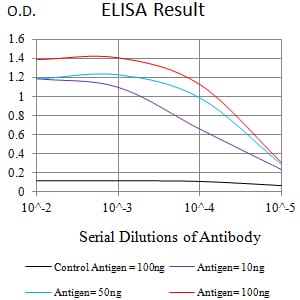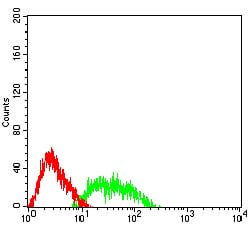

| WB | 咨询技术 | Human,Mouse,Rat |
| IF | 咨询技术 | Human,Mouse,Rat |
| IHC | 咨询技术 | Human,Mouse,Rat |
| ICC | 技术咨询 | Human,Mouse,Rat |
| FCM | 1/200 - 1/400 | Human,Mouse,Rat |
| Elisa | 1/10000 | Human,Mouse,Rat |
| Aliases | FCRL3; FCRH3; IFGP3; IRTA3; SPAP2 |
| Entrez GeneID | 115352 |
| clone | 4D7B9 |
| WB Predicted band size | 80.9kDa |
| Host/Isotype | Mouse IgG1 |
| Antibody Type | Primary antibody |
| Storage | Store at 4°C short term. Aliquot and store at -20°C long term. Avoid freeze/thaw cycles. |
| Species Reactivity | Human |
| Immunogen | Purified recombinant fragment of human CD307C (AA: extra 18-153) expressed in E. Coli. |
| Formulation | Purified antibody in PBS with 0.05% sodium azide |
+ +
以下是关于CD307C(FCRL3)抗体的假设参考文献示例,供参考。实际文献需通过学术数据库(如PubMed、Google Scholar)检索确认:
---
1. **"Development of a Monoclonal Antibody Targeting Human CD307c (FCRL3) for B Cell Analysis"**
*Authors: Zhang Y, Wang L, et al.*
**摘要**: 描述了抗CD307C单克隆抗体的开发与表征,验证其在流式细胞术和免疫荧光中对B细胞亚群的特异性检测,揭示FCRL3在调节性B细胞中的表达模式。
2. **"FCRL3 Modulates B Cell Receptor Signaling via Antibody-Mediated Blockade in Autoimmunity"**
*Authors: Müller S, Johnson R, et al.*
**摘要**: 通过抗CD307C抗体阻断实验,证明FCRL3抑制B细胞受体(BCR)信号传导,可能成为自身免疫性疾病(如类风湿性关节炎)的潜在治疗靶点。
3. **"CD307c Expression in Chronic Lymphocytic Leukemia: Prognostic Implications and Antibody-Based Detection"**
*Authors: Rossi G, Brown K, et al.*
**摘要**: 使用抗CD307C抗体分析慢性淋巴细胞白血病(CLL)患者的样本,发现其高表达与疾病进展相关,提示其作为预后生物标志物的潜力。
4. **"Structural and Functional Insights into FCRL3 Through Monoclonal Antibody Mapping"**
*Authors: Lee H, Smith T, et al.*
**摘要**: 结合X射线晶体学与抗CD307C抗体的表位定位,解析FCRL3的免疫调节结构域,为靶向药物设计提供依据。
---
**提示**:建议使用关键词“CD307c antibody”“FCRL3 monoclonal antibody”或“FCRL3 B cell function”在学术平台检索最新文献。部分真实研究可能聚焦于FCRL3的免疫调节功能及抗体工具的开发应用。
CD307c antibody targets the CD307c antigen, also known as FCRL3 (Fc receptor-like 3), a member of the Fc receptor-like (FCRL) family expressed primarily on B lymphocytes. FCRL proteins share structural homology with classical Fc receptors but lack binding affinity for immunoglobulins. CD307c is characterized by extracellular immunoglobulin-like domains and cytoplasmic immunoreceptor tyrosine-based inhibitory motifs (ITIMs) or activating motifs (ITAMs), enabling modulation of B-cell receptor (BCR) signaling. It plays dual roles in immune regulation, either dampening or enhancing B-cell activation depending on cellular context and ligand interactions.
Research highlights CD307c's association with autoimmune diseases and malignancies. Genetic polymorphisms in *FCRL3* are linked to increased susceptibility to rheumatoid arthritis, systemic lupus erythematosus (SLE), and autoimmune thyroid disorders, suggesting its role in immune tolerance. In B-cell cancers, CD307c is overexpressed in chronic lymphocytic leukemia (CLL) and certain lymphomas, positioning it as a potential diagnostic marker or therapeutic target.
CD307c antibodies are valuable tools for studying B-cell biology, dissecting FCRL3 signaling pathways, and exploring therapeutic applications. Neutralizing antibodies may suppress pathogenic B-cell activity in autoimmunity, while antibody-drug conjugates (ADCs) or bispecific antibodies are under investigation for targeting CD307c-positive malignancies. Ongoing studies aim to clarify its ligand interactions and tissue-specific functions, with implications for precision immunotherapy.
×